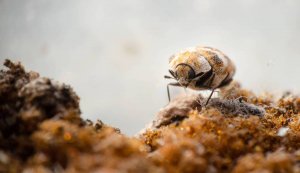While the short answer to this question, “do carpet beetles bite”, is no, the longer version is a bit more complicated because these insects do cause allergic reactions and are not much fun to live with, near or around.
They can be a major source of irritation in a number of ways. Coming in contact with the bristle-covered larvae can cause an itchy rash that is sometimes mistaken for bed bug bites.
These insects ruin items made from animal products such as:wool; silk; hair brushes with natural bristles; pet hair; feathers and fur by both feeding on them and creating holes.
These materials contain keratin, which is a fibrous animal protein that the larvae are able to digest.
Once they gain ingress to a residence, as adults these insects both feed on and lay their eggs in stored pantry products which include: cereals, flour, rice products, and other dry goods.
What Exactly Are Carpet Beetles?
Obviously critters with an unimaginative moniker, besides this redundant fact, adults are small (1/16-1/8-inch) and oval shaped with colors that range from black to mottled patterns of white, yellow, orange and brown.

They feed on carpet fibers, but are first found outside homes in gardens feeding on plant nectar and pollen.
While their natural habitat is outdoors, when foraging for food-sources they often get inside homes via cracks and crevices in exterior walls and foundations, gaps found around windows, doors or via openings near utility line entrances.
They can also gain entry as hitchhikers in packages of purchased dry goods that are already infested with their eggs or larvae.
The pest-control and pest-maintenance specialists at Pestco warn that clusters of beetles appearing on window sills is a sure sign of an infestation inside a residence and a time to not call but rather scream for help.
While carpet beetles have no interest in biting humans and have no mandibles to pierce the skin via a bite, they do like human hair, both when attached to sleeping heads and on brushes left exposed (ugh, eew and more ugh. More on this fact follows below).
Humans are never, however, part of their menu fare. They focus on fabrics, crumbs and assorted debris.
Female beetles lay their eggs in sometimes unexpected and hard to find places, such as accumulations of pet hair, in baseboards, air vents and ducts, but most often are found in obviously vulnerable materials such as rugs and carpets.
Tips For Preventing Carpet Beetle Infestations
Our pest-control and pest-maintenance specialists suggest the following strategies to avoid both costly damage to furnishings and significant aggravation.
There is little solace in the fact fact that these insects don’t bite humans because cause devastating damage to the things human hold dear; namely, precious fabrics and furnishings.
Consider some (or all) of the following tips to protect your belongings from the onslaught of carpet beetles.
-
- Always launder fabrics and woolen items before storing them for long periods.
- Even if not being placed in storage, these items should be cleaned on a regular basis so that the eggs and larvae of the beetles cannot thrive.
- Articles made of wool and fabric should be packed with flakes, mothballs or crystals of Paradichlorobenzine, and then placed in tightly sealed containers.
- Do not use insecticides on clothing or bedding.
- Keep sprayed items away from children and pets.
- Check the home for ceiling and wall cracks and repair them as quickly as possible to prevent carpet beetle ingress.
- Select synthetic materials for interior carpets and furniture as carpet beetles are repelled by them.
- Store clothing materials and fabrics in tightly sealed plastic bags.
- Clean rugs, draperies and upholstered furniture thoroughly and on a regular basis. Frequent vacuuming can remove both food sources and carpet beetle eggs, larvae and adults.
- To locate infestation sources, check all areas where lint, dog or cat hair tend to accumulate, which includes both under carpets and along carpet edges, floor cracks and ducts.
A Few Interesting Facts About Carpet Beetles
Our teams suggest that understanding these things furthers knowledge that can help locate sources of infestations and understand how to protect your precious surroundings.
1. There Are More Than 180 Species Of Carpet Beetles
The most common species found across America include: the varied carpet beetle, the common carpet beetle, and the furniture carpet beetle.
2. Some Of Their Food Sources Are Creepy
Carpet beetle larvae are attracted to the scent of essential oils often found in human hair. These insects are known to crawl across sleeping people in order to feed on and lay eggs in their hair.
3. Carpet Beetles Have An Unusual Life Span
It can take up to three years for carpet beetles to grow from an egg to an adult. As adults, they only live between 13 and 44 days. They are most destructive as larvae.
4. Carpet Beetles Have a Variety Of Names
Some other monikers include: skin beetles; larder beetle; hide; leather and khapra beetles; varied carpet beetle; black carpet beetle; furniture carpet and common carpet beetle. Varied carpet species get their name from the rainbow of colors on their backs.
5. Carpet Beetle Adults Destroy Gardens
Dietary regimens change as the beetle ages. Adults feed on nectar, pollen, plants and ornamental blooms with light colored petals in outdoor gardens, but if they can gain ingress to a home via cracks or other openings, they become pantry pests and will invade cereal, flour and rice products.
6. Carpet Beetles Are Attracted To Light
This factor motivates them to find a way inside towards the light via cracks in doors and windows or openings near plumbing entrances, electrical ducts, vents, and even chimneys.
7. Black Carpet Beetles Infest Kitchens
This species is most commonly found in the northeastern United States and is known for infesting kitchen cabinets and contaminating dry food stuffs
8. Carpet Beetles Avoid Synthetic Materials
Rugs and carpets comprised of cellulosic synthetic materials are not likely to be invaded by carpet beetles unless they are very soiled. These insects cannot digest linen rayon, polyester, nylon or acrylic fibers and generally leave them alone.
9. The Shape And Size Of Carpet Beetle Larvae Depend Upon Species
Despite this, most carpet beetles are elongated with varying degrees of hair tufts on their bodies. Colors range from from dark to light brown. Varied carpet and furniture beetles also bear uniquely colored scales specific to type.
10. Carpet Beetles Are Similar To Moths
The two insects share an attraction to light, which they mistake for the moon that instinctively guides their nocturnal activities, and the fact that they cause serious damage to fabric. Carpet beetles, however, tend to eat a large section of fabric while moths are known to create tiny holes all over diverse garments.
Call Pestco For Any And All Things Pest-Related!
If you believe you may have a carpet beetle infestation, or have any other types of pest control needs, be sure to call our teams today! We are always here to help!

Photo Credits: Pixabay and Shutterstock
 Over 300 Reviews
Over 300 Reviews 